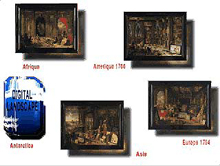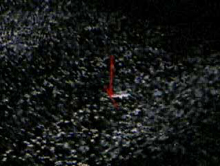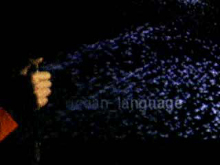|
KNOWBOTIC
RESEARCH
http://www.?
| |
 |
| |
|
 |
1995, Dialogue
with the knowbotic South |
| |
|
| |
 |
| |
|
| |
1995, Dialogue
with the knowbotic South |
| |
|
| |
 |
| |
|
| |
1995, Dialogue
with the knowbotic South |
| |
|
| |
|
Self-organizing
interactive audio installations
The SMDK simulator is a simulation chamber for mobile digital sound.
The digitized sounds come from the Internet and are put at the public’s
disposal inside a dark room. The visitors explore the space of this
room and can activate the intertwining wreaths of autonomous sounds.
By means of a helmet, the user is integrated into the computerized
system where the sounds all have symbolic presence. These sounds
organize themselves, according to their similarities, inside a sound
database. Each sound has a particular signature which it is possible
to identify. So the sounds attract each other and come together
in groups according to certain affinities. But the system remains
a fluctuating one, since each sound has a certain number of particularities
and can therefore leave one group for another. Within the computerized
space, isolated groups can therefore be made out. The visitor is
represented by a cursor which he or she moves, setting off the reorganization
of the sounds.
A
sound system in virtual reality
The visitor is an active part of the whole system. Without spatial
dissociation, this visitor is part of the mobile digitized audio
environment, the SMDK, designed on the basis of a scientific model.
Immersed in this virtual universe, the visitor’s action sets
off a sound effect in real space and transforms the initial environment.
In order to navigate inside this system, the visitor is equipped
with a monocular display helmet. With one eye, the visitor has access
to the virtual space and with the other he or she can simultaneously
explore the real space. The information coming from the virtual
space is presented, notably, in the form of diagrams which show
the relative distance between the different sound groups, and a
typology of the sounds themselves. By his own movements, the visitor
can intervene on the data.
The loss of precision of different
objects
Within the frame of the networks, different objects are associated
in a rough and ready manner, under the pretext of reaching new knowledge.
This strategy, this process, leads in reality to a loss of definition
of the different objects. In order to create events, the Knowbotic
Research group is pushing even further in this direction, seeking
to bring objects out of their usual delimitations and to make them
malleable. Since the objects are no longer presented as such, it
is possible to intervene on them and to modify them — to cross
their frontiers. It is a very complex activity, in which it is possible
to envisage the creation of relations between objects. Thanks to
the visitor’s interaction with the digital elements, these
are permanently modified within the clearly defined limits of the
installation.
1995, Dialogue with the knowbotic South
This installation,
set up in liaison with the Antarctic, integrates computerized data
collected in the field with the data processed by knowbots, intelligent
active agents, at large on the internet. The user interacts with
these knowbots in a virtual environment, by means of a viewing helmet
and a three dimensional audio system.
|



